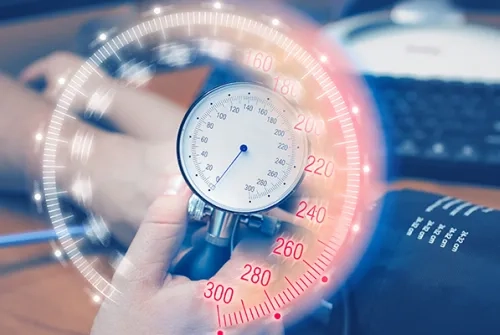Alo Yeditepe
Alo Yeditepe
What is Renal Denervation?
What are the Non-Drug Treatment Methods for Resistant Hypertension?
The foremost among non-drug treatment methods for resistant hypertension is the procedure known as renal denervation or renal catheter ablation. The basis of the procedure is the abnormal signaling system observed, especially in patients with hypertension, within the triangle of kidneys, heart, and brain, known as the renal-heart-brain triangle.
In fact, the body responds to various stresses with each of its organs and communicates internally. Near the renal artery region, there are sympathetic nerve fibers that send signals to the brain and heart. In patients with resistant hypertension, sympathetic nerve fibers show excessive activity, producing signals well above normal. Consequently, the excessive release of stress hormones leads to inappropriate increases in blood pressure. With the renal denervation procedure, radiofrequency energy is applied to these inappropriate, overactive nerve fibers around the renal arteries. This suppresses the inappropriate excessive activity, preventing the elevation of blood pressure.
Who Can Undergo Renal Denervation?
Renal denervation is applicable to individuals, particularly those with resistant hypertension, whose blood pressure remains uncontrolled despite using three or more medications, and to patients who cannot use medication due to side effects or have been unsuccessful in treatment due to medication intolerance. Patients with medication tolerance are considered the target audience for renal denervation therapy. Scientific studies focusing on two different catheters used in renal denervation have been conducted since the early 2010s in these patients. With the latest generation renal denervation catheters used since 2020, the effectiveness and safety of this treatment have been demonstrated.
Therefore, this method is safely employed, especially in patients who use multiple medications and still cannot control their blood pressure, those with medication intolerance, or patients with poor medication adherence.
How is the Renal Denervation Method Applied?
The renal denervation method is applied using the classical angiography technique. Admission procedures for the patient are carried out the day of or one day before the procedure. The procedures are generally performed by entering through the groin vessel.
The procedure is technically applied in angiography laboratories following angiography principles. Usually, by entering through the groin artery, catheters, special devices allowing us to enter the renal arteries, and a radiofrequency energy-providing device are used to perform the ablation process on the nerve fibers around the renal arteries. After completing the ablation process separately for each renal artery, the catheters are removed, and the entry site in the groin artery is closed using angiographic techniques. Following overnight monitoring in the hospital, the patient is generally discharged the next day.
Is Renal Denervation Applied to Both Renal Arteries?
The reason for the procedure is the inappropriate action in the renal arteries, so this process is carried out for both arteries of the kidneys.
What is the Success of Renal Denervation in the Treatment of Resistant Hypertension?
If the appropriate patient is selected, it is possible to achieve quite successful results with the method. Therefore, this procedure can be easily performed in a very broad group of patients with the option of selecting the right patient. However, factors such as having the procedure performed by a specialized physician, completing it in a timely manner, and individually applying the procedure to each of the two renal arteries are among the factors that influence the overall success of the renal denervation procedure. This method is not suitable for patients with stenosis in the renal arteries.
What Should Patients Pay Attention to After Renal Denervation?
As hypertension is a chronic condition, patient compliance is of utmost importance after treatment. The discipline should be maintained throughout life. Medication therapy, lifestyle changes are as crucial as interventional methods. The patient should pay attention to salt restriction, excessive alcohol consumption, and regular exercise throughout their life.
This content was prepared by Yeditepe University Hospitals Medical Editorial Board.
”
See Also
- What is Heart Rhythm Disorder (Arrhythmia)? Symptoms and Causes
- How Do We Know When We Have a Heart Attack?
- What is Sudden Cardiac Death? What are the Symptoms?
- Risk Factors in Heart Diseases
- Heart Valve Diseases and Treatment Methods
- How Do Heart Disease Risk Factors Affect Women and Men?
- What is a Heart Attack? What are the Symptoms of a Heart Attack?
- What is Broken Heart Syndrome? Symptoms and Treatment
- Carotid Artery Disease
- What is Intravenous Ultrasound (IVUS)?
- Renal Denervation in Hypertension Treatment
- What is TAVI?
- Is Your Heart Ready For Winter?
- The Risk of High Blood Pressure Increases as You Go to High Altitudes
- By 2025, Hypertension Patients Are Expected to Reach 1.5 Billion
- Misconceptions about the Female Heart
- Blood Pressure Holter
- Coronary CT Angiography (Virtual Angiography)
- Effort Test
- Heart Attack Causes and Symptoms
Alo Yeditepe








